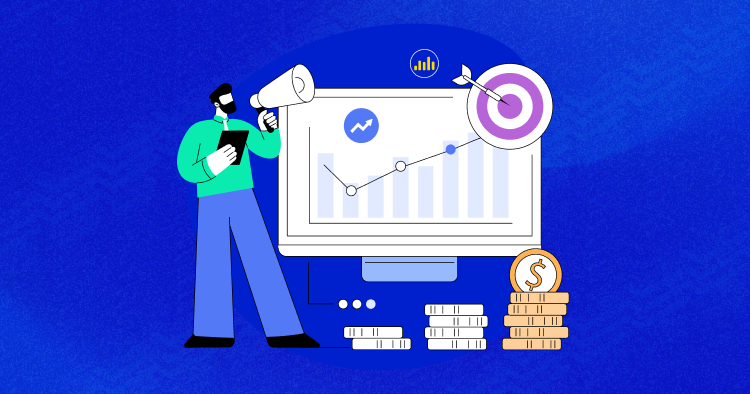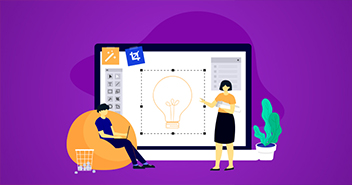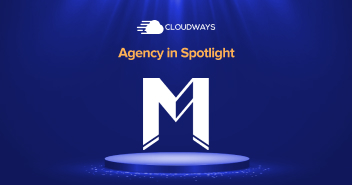
Today, James Cooper is a successful agency owner.
His agency has excellent retention rates with over 100 active clients and enjoys a 73% YOY increase in revenue and a 42% increase in profitability. These are impressive figures, especially in such uncertain economic times.
But this wasn’t always the case. James had a fair share of struggles when he initially started. Two years in business, and he faced a dead end.
His agency wasn’t growing, and he wondered if he could ever move from insolvency to sustainability. Then how did he manage to achieve such impressive results?
When experiencing stagnation, James’ frustration pushed him to take his efforts to another level. That’s when he identified a few main growth challenges and how he could resolve them via some important metrics.
That was the EUREKA moment for the man! And the game has changed for him since then.
Many agency owners can fit perfectly into the shoes of struggling James. And things can turn around for them too!
Are you someone looking to grow their agency? Then you’re at the right place, as this article is all about increasing profitability by implementing and paying attention to some vital key metrics.
Key Metrics That Matter For Agency Growth
Challenge # 1: Onboarding Bad-Fit Clients
Small agency owners find bad-fit clients among the biggest challenges for their businesses.
Usually, small agencies have difficulty saying no to projects, making them pick up misfit projects.
Result: unsatisfied clients who may spread bad word of mouth about your business.
This can be detrimental for small agencies as they highly depend on referrals for their work.
The good news is that you can eliminate this challenge by measuring the metrics discussed below:
1. Customer Churn Rate
Churn rate can help you identify bad-fit clients, as it tells you how many clients are leaving and why.
You can calculate the churn rate by dividing the number of lost customers in a given period by the total number of customers acquired at the start of the period.

A higher churn rate shows that clients are unsatisfied, and you might lose more clients soon. Anything could be the problem, including having poor customer service. In such situations, adopting a business phone service can help reduce your churn rate.
Project-based agencies can improve their churn rates by taking feedback from their clients (especially unsatisfied clients) to identify potential issues.
For an agency with retainer clients, a turnover rate of 25% or more may indicate problems that endanger other retainers and can be improved by improving customer satisfaction.
Some measures to improve churn rate figures include:
- Taking feedback from leaving clients to identify potential issues
- Hiring a competent customer success manager
- Improving customer services
- Determining customer-specific needs
Agency owner Mike Owens, Digital Marketing & Growth Director at Web Hosting advice, sheds light on churn rate as:

“In my experience, agencies that accept a wide variety of clients soon find that many of them quit within the first few months. It is impossible to please everyone. To determine if you are a good fit for the client, it is best to learn about their requirements. The average turnover rate should be under 10% according to the best practices in the sector.“
2. Customer Lifetime Value
The lifetime value of a customer is another helpful metric for an agency’s growth.
You’ll find it challenging to set growth goals if you don’t know how much money each client brings for your business throughout their relationship with you.
The real kicker is that you can effortlessly determine your LTV (Customer Lifetime Value) by multiplying your revenue by the average customer lifespan with your brand.

Agency owners can try upselling and cross-selling strategies to lengthen their clients’ lifetimes.
Simonas Steponaitis, a Marketing Manager at DoFasting, highlights LTV as their essential metric:

“Customer lifetime value (CLV) is a measure of how much revenue you can expect to earn from each customer throughout their entire relationship with your business. By understanding your CLV, you can determine which marketing initiatives drive the most value for your business and focus on more cost-effective channels moving forward.“
Challenge # 2: The Uncertain Economic State of the Industry
Small agencies often sacrifice their profitability to stay competitive and survive uncertain economic times. But a poor pricing strategy can stall progress, making it difficult for the agency to stay afloat.
It is recommended to measure profit margins and profitability per client as accurately as possible to withstand economic downturns. Here are some key metrics you can target to up your agency’s number game.
3. Net Profit Margins
Net profit margins benefit agency owners in making growth decisions, as it shows how much they make for every dollar spent. This metric indicates how well the agency uses its resources to generate profits.
To calculate your profit in the form of net margin, divide your net profit by the total revenue and multiply the result by 100 to express in %.

Agencies usually have a 15-20% average margin. However, agencies in growth mode may have a net profit margin of 8% to 12%.
Measuring net profit margins can help small agency owners determine if they should adjust prices, discontinue services with weak margins, and identify time-taking and costly processes.
Linda Chavez, the Founder & CEO of Seniors Life Insurance Finder, talks about net profit margins as:

“If your agency is meeting its related costs but doesn’t have much profit margin left over for expanding operations or reinvestment, it may be time to reevaluate the efficiency of your operations and make some strategic changes.“
4. Profitability Per Client
Client-based agencies have a difficult time tracking profits. It requires you to break down the profits per client to reach the company’s net profit figures.
So the profitability per client metric helps you identify high-paying clients and decide how to make them recurring and increase their lifetime value.
Also, this metric helps divert resources from low-paying clients to high-paying ones and identify difficult ones costing more time and money.
Michael Hess, Ecommerce Strategy Lead at Code Signing Store, says:
 “It is crucial to know how much each client contributes to your total profit. For example, if certain customers aren’t paying their fair share, you’ll learn why that is and how to address the problem.”
“It is crucial to know how much each client contributes to your total profit. For example, if certain customers aren’t paying their fair share, you’ll learn why that is and how to address the problem.”
Join Our Agency Partnership Program to Supercharge Your Agency Growth
Want to streamline your agency processes and know what tools and platforms can boost your agency’s growth? Join our agency partnership program for all of this and enjoy discounts, co-marketing opportunities, and more!
Challenge # 3: Unproductive Teams
Small agencies have limited employees and face productivity challenges every now and then. Unproductive workplaces negatively impact growth, resulting in a loss of customers.
If your team is experiencing productivity issues, then the agency utilization rate can come to the rescue.
5. Agency Utilization Rate
The agency utilization rate metric indicates how much time each employee spends on tasks that directly impact the company’s bottom line and could vastly improve profitability.
You can calculate your agency’s utilization rate by dividing the number of billable hours by the number of available work hours.

A high rate can indicate overuse of your resources, and a poor rate may mean you must bring more work to the table.
A 100% rate may mean your staff uses all their time due to a lack of expertise, and the optimal rate should be between 85-90%.
You can use time-tracking apps to determine time spent by individuals on work. It will help improve the workflow.
Tia Campbell, Director of Marketing at *Practice Reasoning Tests, gives her insights on AUR:

“A 100% AUR isn’t always a strong indicator of quality. Your staff may use up their time because they lack the necessary expertise.”
Challenge # 4: Inconsistent Sales and Marketing
Marketing and sales are central to agencies. Oftentimes, agencies overlook both because they feel they are less important than the other aspects of their business.
But to move best-fit clients through the funnel, it is necessary to employ cautious planning and fair spending in marketing and sales.
Also, agencies should focus on expanding and marketing their own business since they often worry about running out of projects. The following three metrics are critical to know the fruits your marketing efforts will bear.
6. Average Qualified Leads
An MQL, or marketing-qualified lead, is a potential customer who has interacted but is still away from sales funnels. These challenging leads can use content, case studies, testimonials, and word of mouth to nurture.
Once they qualify to speak with a sales representative, they are considered sales-qualified leads or SQL. Though calculating these leads is challenging, you can collect them by measuring their web activity, email activity, and corporate data.
To calculate the average qualified leads, divide the number of qualified leads by the sum of total leads, and multiply their result by 100.

JeffMains from Champion Leadership Group LLC highlights MQLS as:
 “The trick is to focus on serious buyers rather than everyone who wants to look around and ask for the prices in your shop. Your sales team should keep track of new leads and note the sources from which the qualified leads are coming.”
“The trick is to focus on serious buyers rather than everyone who wants to look around and ask for the prices in your shop. Your sales team should keep track of new leads and note the sources from which the qualified leads are coming.”
7. Lead Conversion Rate
Getting leads is one thing, but converting them into sales is a different ball game. Here, the lead conversion rate can come in handy.
It can be easily calculated by dividing the total number of conversions by the number of leads and multiplying the result by 100.

Stephan Baldwin, founder of Assisted Living, a healthcare marketing agency, highlights:
 “We set a monthly goal for earning qualified leads and adjust it accordingly. It’s a constant learning process because customer behavior changes with the seasons. But following this metric has helped us uncover certain trends to help us stay on track with our marketing.”
“We set a monthly goal for earning qualified leads and adjust it accordingly. It’s a constant learning process because customer behavior changes with the seasons. But following this metric has helped us uncover certain trends to help us stay on track with our marketing.”
Get High-Converting Client Proposal Samples
Avoid the legwork of creating templates and process documents for your agency with our useful collection of templates, designed to help you streamline and better manage core agency processes. You can download one, or all templates for free in the form of our Agency Resource Pack.
8. Win Rate
Win rate helps to identify potential changes to be made in the pitch. You can calculate the win rate by dividing the number of proposals won by the total number of submissions sent and multiplying the result by 100.

Agencies should strive for a 60-70% rate, as 90% or higher win rates may indicate that you need to send more proposals or that your prices are not competitive.
Also, win rates lower than 50% may show over-proposition, as your prospects may not be your targeted customers, or your sales team needs to work more efficiently on the right strategies to grab customers.
Travis Lindemoen, Managing Director of Nexus IT Group, describes the win rate as follows:
 “The win rate is another key performance indicator that can help you keep your sales team accountable and pinpoint areas where you can improve your sales presentation.“
“The win rate is another key performance indicator that can help you keep your sales team accountable and pinpoint areas where you can improve your sales presentation.“
9. Customer Acquisition Cost
The customer acquisition cost (CAC) helps businesses keep healthy profit margins and allocate funds for marketing. Every business must calculate its CAC to identify its most effective channel.
You can easily calculate CAC by dividing the total costs of each marketing channel by the number of customers acquired during the same period.

The same CAC for all customers does not work, and spending more on a high-payer customer is more advantageous. So, you must divide the customer base between high-payers and low-payers
For e.g., for a client paying $10k per year, an acquisition cost of $100 is reasonable but not acceptable for a client paying $1k per year.
The optimum CAC should be the fifth part of the value of the real deal. Once you determine CAC, compare it with the average cost in the market to know if your profit margin is compatible.
An easier way to reduce your CAC is by using organic channels and word of mouth instead of paid advertisements.
Bram Janson, Co-Founder of VPNAlert, shared his valuable insights on metrics:
 “The key combination of customer acquisition cost (CAC) and customer lifetime value (CLV), in my opinion, offers you a robust understanding of your company’s health.“
“The key combination of customer acquisition cost (CAC) and customer lifetime value (CLV), in my opinion, offers you a robust understanding of your company’s health.“
Challenge # 5: Poor Cash Flow
Poor cash flow in an agency can arise from low-profit margins, over-investing in capacity, and, most commonly, client invoicing and collecting payments that take weeks and even months to be paid.
These poor flows can create a financial burden, slow normal workflows, and negatively hit the agency’s overall growth objectives. As a result, you miss growth opportunities.
Hence, measuring cash flows and net profit margin is crucial for your agency to avoid poor cash flows.
10. CashFlow From Operations
It’s important to regularly monitor the cash flow position and conduct regular business health checks to correct any problem that may arise while expanding your agency.
Robert Warner, an Official Member of the Forbes Agency Council, highlights:
 “Cash Flow from Operations is, in my opinion, the most important statistic used by agency owners for monitoring profitability. The timing of client billing has a significant effect on revenue coming in and should be given priority.“
“Cash Flow from Operations is, in my opinion, the most important statistic used by agency owners for monitoring profitability. The timing of client billing has a significant effect on revenue coming in and should be given priority.“
11. Net Profit
Net profit represents the amount left over from sales after deducting all expenses. It helps determine if your business is on track for optimum profitability.
Low net profits are concerning. And analyzing them highlights expenses that need to be reduced.
For example, it may alert you to reduce the amount spent on marketing or on office space. Alternatively, you might need to find ways to increase sales or charge higher prices.
Michael Chepurnyak, CEO and Founder of Eindesein, highlights:
 “In general, we calculate gross profit from our projects, operating profit (GP salaries, administrative expenses, etc. We are working remotely, so we save on rent here, too), and net profit. As a company founder, I am also interested in ROI numbers.”
“In general, we calculate gross profit from our projects, operating profit (GP salaries, administrative expenses, etc. We are working remotely, so we save on rent here, too), and net profit. As a company founder, I am also interested in ROI numbers.”
Summary
Metrics show your company’s true health and performance. And among the zillions, you must focus on a few key ones that help you tackle your agency’s challenges.
The metrics provided in this blog are among the common ones that help agencies prosper and make healthy profits. See which ones are relevant and in line with your agency.
Sure, there are a lot more that aren’t covered here. You can continue to hunt for them in other places as well. But we’ll leave you with just one point – metrics are really important if you want your agency to grow.
Without them, everything will become an unsystematic mess that’ll be an uphill task.
Overcome Your Challenges with Cloudways!
Enjoy co-marketing opportunities, earn clients’ trust, and get featured in exclusive interviews, case studies, and more through our Cloudways Agency Partnership Program.
Fatima Muhammad
Fatima is a Digital Marketer at Cloudways. She believes consistency coupled with hard work is the perfect recipe for success. She loves to read, cook, watch Netflix, and spend time with her beautiful daughter.


